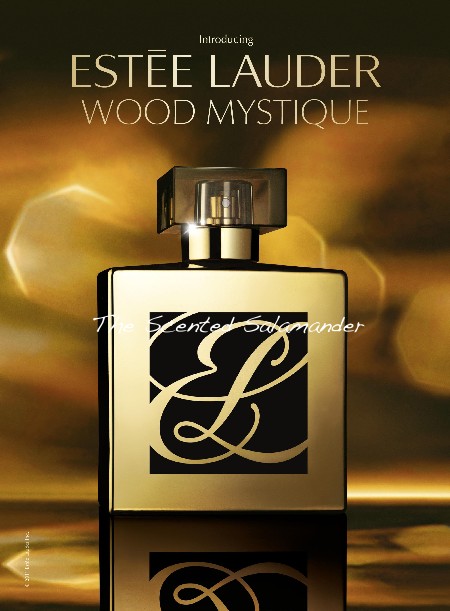Estée Lauder Wood Mystique: Ostentatious & Hidden Luxury (2011) {Perfume Review & Musings}

As announced earlier, American household name Estée Lauder has decided to turn their exclusive attention to the Middle East markets by proposing an oud composition tailored to the tastes of the inhabitants of the region.
While it has been noted several times on the blog in the past few years that the appearance and establishment of the olfactory note of oud within the palette of the perfumer is an East-to-West movement, it appears that for their latest atypical launch, Estée Lauder are also playing the acculturation card in the reverse order by introducing dewy and watery textures in a medium usually used to convey the deep vibrato of woods, the depth of animality and the smokiness of both mystical and erotic incense.
Despite this crosscultural sectioning of aromas, Wood Mystique in the end pays homage, as promised, to the taste for riches and opulence of the Middle East. But there is a lesson to be learned here as well in the days of the modern-day sensory experience of the Western sillage: with this composition, we discover a type of sillage which is at once ostentatious and (nearly) private, in keeping, it seems, with predominant sartorial codes in the Middle Eastern cultures...
Oud as a perfume for the body is often smelled not coming from the skin directly but as mediated by the folds of veils and clothes which cover up the skin. Or it might be that the clothes have been smoked with burning chips of oud. The Estée Lauder rendition of the experience of oud keeps some of those particularities.
Notes: distilled rose, peony petals, pink pepper/ Rose de Mai absolute from Grasse, rose infusion, Egyptian jasmine absolute, Mimosa Provence absolute, Orris Morocco and ylang/ patchouli, leather, Indonesian benzoin, cedarwood SFE, agarwood, a hint of raspberry.
The perfume Wood Mystique, composed by perfumer Jacques Cavallier, offers the paradoxical effect at first of a fresh oud seemingly drenched in water. The perfume Jo Malone Intense Rosewater and Vanilla with its discreet note of oud, played upon this type of contrast and reference, but not as obviously as in this case. There is a waterfall quality here in the top notes which may make sense as a precious note in countries where natural water sources are scarce. The rosewater note connotes as a sign of refinement and hospitality and not of tonic lotion as in the West. This is moments before a powerful, animalic and moderately medicinal accord of oud with camphoraceous accents, develops to belie the initial impression. While the bristly-seeming oud note - it feels akin to smelling a hairbrush with boar bristles having sunk into a vat of perfume) - is pungent and not overly concerned with toning it down, there remains a transparent facet, with metallic overtones, creating a contrasted texture to the wet-leather quality of oud. The rose featured here smells of rose absolute, with its metallic and green accents. It smells of Bulgarian rose to me, although only a Rose de Mai absolute is advertized. A discreet undercurrent of white vanilla adds a sweet, softening nuance as well as a tinge of jammy gourmandise, together with the raspberry.
The rose is less than demure offering instead an animalic facet coming off as dirty, with prickly edges enhanced by a mustardy nuance (cf. Sinigrine and Myrosine), all with the goal to perpetuate and cultivate the harsh, difficult nuances of the classic, central oud-and-rose accord. The unisex positioning of the scent may warrant this less-than-pretty rose, an effect which can be compared with the elemental energy found in the masculine rose of Penhaligon's Hammam Bouquet. If I half-expected Wood Mystique to perhaps smell a bit like Frederic Malle Portrait of a Lady due to its classical qualities, I am proven wrong. It smells a bit more like the more modern Miss Pucci in which a similar mineral-woody quality is found.
There is something raw and elemental about the perfume at the core, which is only attenuated by a certain ornamental perfumey quality. The oud note manages to be both harsh and precious.The tension evokes to the mind the contrast of polished gold jewelry and hostile sand desert.
Wood Mystique even as it mellows down further never quite loses its sense of contained power. As the composition becomes spicier and more shimmering, the perfume becomes more like oud turned into scintillating gold dust and glimmering gold brocade. The woody notes refine themselves to become more like precious scented woods: chests of sandalwood and cedarwood containing incense, gold, silk, and brocades.
What I retain most from this oud composition is its understated, golden, shimmery quality. The press materials use the expression "a hidden communicator" to describe the sillage of the fragrance and one has to acknowledge that those words take on their full meaning after experiencing the scent. Literally, the perfume's sillage seems to be covered-up and function from underneath your garments. You perceive at some points in time a rich, sinuous, yet very private trail which seems to be the gold-and-precious-stones equivalent of Tom Thumb's trail of pebbles. It evokes wealth more surely than a flashy sillage would with its covert nature. Culturally, it seems also to take into account the sartorial culture of the region and a daily experience of the hidden in sartorial fashion and habitat.
If the construction of clothes can directly influence the construction of perfumes, a question that can be pondered at lengths and theorized, it undeniably may help design a different form of wake in countries which need a sillage than can sneak up from underneath added layers of garments. Oud already has that capacity, which I felt was well exemplified in Al Oudh by L'Artisan Parfumeur, albeit reined in.
It seems that the dark, animalic force of the recreated material was harnessed and tamed to offer an understated bejeweled Arabian. Perfumery is if nothing else, about creative oxymorons.









